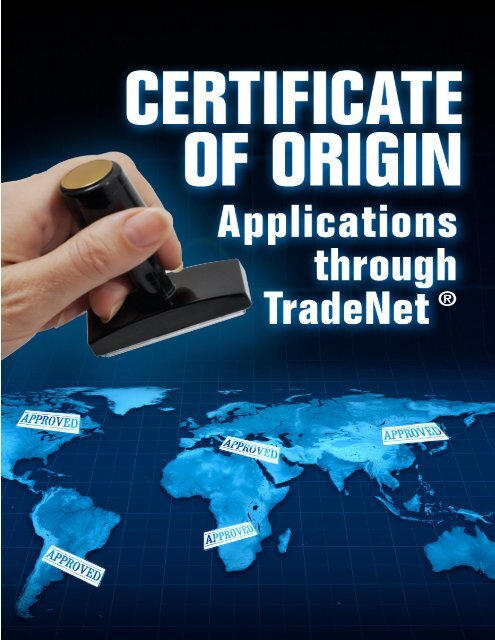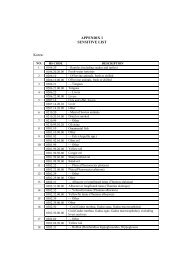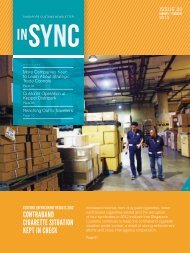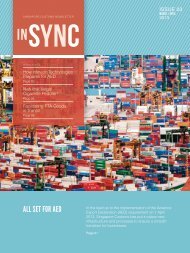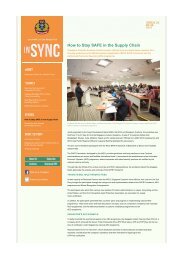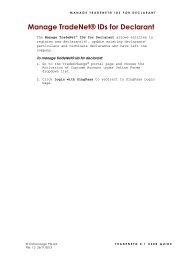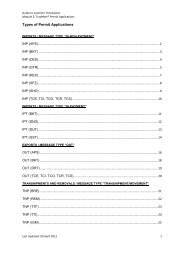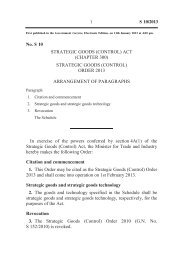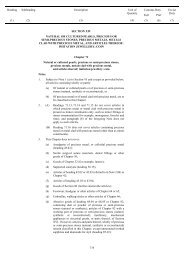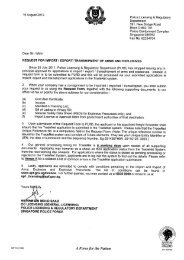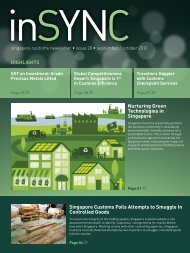Content - Singapore Customs
Content - Singapore Customs
Content - Singapore Customs
You also want an ePaper? Increase the reach of your titles
YUMPU automatically turns print PDFs into web optimized ePapers that Google loves.
CONTENTS<br />
1 INTRODUCTION<br />
2 OPERATION PROCEDURES FOR THE APPLICATION OF<br />
CERTIFICATE OF ORIGIN AND THE EXPORT PERMIT THROUGH<br />
THE TRADENET SYSTEM..................................................................... 5<br />
3 OTHER USEFUL INFORMATION .................................................. 12<br />
4 EXPLANATORY NOTES ............................................................... 15<br />
JAN 2012<br />
2
1 INTRODUCTION<br />
1.1 Certificate of Origin<br />
A Certificate of Origin (CO) is a trade document certifying the origin of the goods to be<br />
exported. Certificates of Origin can be broadly classified into Ordinary CO and Preferential<br />
CO.<br />
<strong>Singapore</strong> <strong>Customs</strong> issues the Ordinary COs and is the authorized agency to issue<br />
Preferential COs under the various Schemes of Preferences and Free Trade Agreements<br />
(FTAs).<br />
1.2 Ordinary Certificate of Origin<br />
An Ordinary CO, also known as non-preferential CO is used to satisfy your overseas buyer<br />
that the products exported are wholly obtained, produced or manufactured in <strong>Singapore</strong>.<br />
1.3 Preferential Certificate of Origin<br />
A Preferential CO not only certifies that the product(s) are wholly obtained, produced or<br />
manufactured in <strong>Singapore</strong>, but it is also a document by which your overseas buyer needs<br />
to claim preferential tariff treatment when importing your products under one of the Schemes<br />
of Preferences or FTAs such as:<br />
a) Generalized System of Preferences (GSP)<br />
b) ASEAN Trade In Goods Agreement (ATIGA)<br />
c) Commonwealth Preference Certificate (CPC)<br />
d) Global System of Trade Preferences (GSTP)<br />
e) Free Trade Agreement (FTA)<br />
A Preferential CO therefore improves the competitive edge for your exports.<br />
JAN 2012<br />
3
1.4 Types of Certificates of Origin<br />
Under TradeNet®, you will be able to apply for the following types of CO -.<br />
Certificate<br />
Type<br />
1 Generalized System of Preferences(GSP), (Form A)<br />
2 GSP (Form A)<br />
under Cumulation Asean<br />
3 Back-to-back GSP Form A<br />
4 Ordinary Certificate of Origin/Processing, (CO)<br />
4A Certificate of Processing<br />
5 Commonwealth Preference Certificate (CPC)<br />
9 Ordinary Certificate of Origin, CO – for textile products exported<br />
to the European Union only<br />
10 Export Certificate - for fresh-cut orchids only<br />
16 ASEAN Trade In Goods Agreement (ATIGA), (Form D)<br />
17 Back-to-Back ATIGA (Form D)<br />
18 Preferential CO under the Free Trade Agreements (FTA)<br />
19 Asean-China Free Trade Area (ACFTA), (Form E)<br />
20 Back-to-Back ACFTA (Form E)<br />
21 Preferential CO under the Comprehensive Economic Cooperation<br />
Agreement (CECA)<br />
23 Asean-Korea Free Trade Area (AKFTA), (Form AK)<br />
22 Back-to-Back AKFTA (Form AK)<br />
25 Asean-Japan Comprehensive Economic Partnership (AJCEP), (Form AJ)<br />
26 Back-to-Back AJCEP (Form AJ)<br />
27 Asean-India Free Trade Area (AIFTA), (Form AI)<br />
28 Back-to-Back AIFTA (Form AI)<br />
29 Asean-Australia-New Zealand Free Trade Area (AANZFTA), (Form AANZ)<br />
30 Back-to-Back AANZFTA (Form AANZ)<br />
JAN 2012<br />
4
2 OPERATIONAL PROCEDURES FOR APPLICATION OF CERTIFICATE OF ORIGIN<br />
1 Specific relevant format of Cost Statement available in <strong>Customs</strong>’ website on Certificate of Origin<br />
JAN 2012<br />
5
2.1 Before You Submit Your Certificate of Origin (CO) Application, you must :<br />
Step 1 as indicated in flowchart – Register as a Manufacturer<br />
The product for export must be manufactured by a factory which is registered with the Tariffs<br />
and Trade Services Branch (TTSB) of <strong>Singapore</strong> <strong>Customs</strong>. If you are the exporter, you must<br />
check if the manufacturer of the product has met this requirement.<br />
2 Exporter may appoint agent.<br />
JAN 2012<br />
6
If not, the manufacturer may register by submitting the “ Manufacturer’s Application Form”<br />
which is available in <strong>Singapore</strong> <strong>Customs</strong>’ website at<br />
“http://www.customs.gov.sg/leftNav/trad/Certificates+of+Origin.htm”. Information on the<br />
registration is available in the same website.<br />
Step 2 as indicated in flowchart – Submit the Manufacturing Cost Statement<br />
Upon successful registration, the manufacturer must ensure that the product qualifies for the<br />
respective CO Schemes. He does this by submitting the Manufacturing Cost Statement<br />
(MCS) of his product to TTSB for verification. This is to ensure that his product meets the<br />
origin criteria for the CO Scheme. MCS procedures and formats are available at<br />
“http://www.customs.gov.sg/leftNav/trad/Certificates+of+Origin.htm” as well as the origin<br />
criteria for schemes other than FTAs.<br />
The Rules of Origin for the respective FTAs are available at “http://www.fta.gov.sg/”.<br />
The approved MCS for the product registered is valid for one year from the date of the<br />
costing subject to the condition that there has not been any change in sourcing patterns or<br />
prices of raw materials and other costs declared in the approved MCS.<br />
2.2 Submitting Application of CO with Export Permit through TradeNet® System<br />
(step 3 as indicated in flowchart)<br />
With TTSB’s letter of verification of the approved MCS, you must submit your application of<br />
CO together with Export Permit through the TradeNet® System. Select Permit Message<br />
Type “OUTDEC/WITH CO”.<br />
Depending on product and where you will like to collect your CO, the Application Product<br />
Type codes are:<br />
NA -<br />
NH -<br />
Application for non-textile products at <strong>Singapore</strong> <strong>Customs</strong> Airport Outpost<br />
(collection of CO at SAAA-Air Cargo)<br />
Application for non-textile products at <strong>Singapore</strong> <strong>Customs</strong><br />
JAN 2012<br />
7
(Collection of CO at CrimsonLogic (CL), Chinatown Point)<br />
TX - Application for textile products at <strong>Singapore</strong> <strong>Customs</strong><br />
(Collection of CO at CL, Chinatown Point)<br />
2.3 Accuracy and Completeness of Your Permit/CO Application<br />
You must check for accuracy and completeness of all the details in your application. The<br />
key areas to check in the application of the Certificate of Origin are:<br />
<br />
<br />
<br />
<br />
<br />
<br />
<br />
<br />
name of consignor and consignee<br />
item nos., to be in sequence<br />
marks and nos. of packages<br />
description of goods. This should be identical to the description indicated on the<br />
invoice and the approved MCS.<br />
the origin criterion must be clearly indicated. This must be according to the rules<br />
and conditions as stated under the various Schemes of Preference<br />
Certificates/FTAs etc<br />
gross weight or other quantity (eg: pieces, kgm, etc)<br />
number and date of invoice. The invoice date in the application must not be later<br />
than the approval date of the Certificate.<br />
Registered Manufacturer, MCS or Letter of Undertaking (renewal for MCS) must<br />
be valid.<br />
Any incomplete or wrong declaration will lead to rejection of your Permit/CO Application or, if<br />
approved, may be subjected to overseas <strong>Customs</strong>’ queries on your goods and CO.<br />
If you are an exporter and you have bought the goods from a local manufacturer, you are<br />
required to provide the name and contact person of the manufacturer at the “Declarant<br />
Remarks” field of your Permit Application as follows:<br />
Name of Manufacturer : _________________<br />
Contact Person : _________________<br />
Tel No. : _________________<br />
JAN 2012<br />
8
2.4 Application for Textiles and Textile Products<br />
For garment products qualifying as originating goods under the USSFTA, you must declare<br />
the Certificate Type as “18” when you declare your application via TradeNet®. If you do not<br />
have the TradeNet® software, you may engage a freight forwarder or a Service Centre to<br />
declare the application on your behalf.<br />
2.5 Application for Retrospective/Retroactive COs<br />
On request by your overseas importers, provided that this is allowed under the rules of the<br />
Scheme/FTA, you may apply for Retrospective/Retroactive CO for shipments that have<br />
been previously exported and Export Permit had been obtained.<br />
Select Permit Message Type – “Certificate of Origin”. An additional detail that you will need<br />
to declare is the Export Permit No. for the shipment to be entered in the “Previous Export<br />
Permit No.” field. Please indicate the Unique Reference Number (URN) on this Export<br />
Permit and attach it as a scanned document at the time of retrospective application via<br />
Tradenet®. Alternatively you may fax it to : 6337 6360 or 6337 6361.<br />
2.6 Approval Message<br />
If you have submitted all the details correctly in your CO and Export Permit application, the<br />
System will approve your application by allotting the CO and the Cargo Clearance Permit<br />
(CCP) with a number each and transmit the approval message back to you.<br />
An example of an approval message is as follows:<br />
A51 – APPROVED BY SINGAPORE CUSTOMS. FOR ALL ITEMS.<br />
Y96 – APPLICATION IS APPROVED ON CONDITION THAT DECLARANT/<br />
EXPORTER HAS EXERCISED DUE DILIGENCE TO DETERMINE THAT THE<br />
JAN 2012<br />
9
GOODS ARE NOT CONTROLLED UNDER STRATEGIC GOODS (CONTROL) ACT<br />
& A STRATEGIC GOODS PERMIT IS NOT REQUIRED. FOR ALL ITEMS.<br />
You must take action on the approval message whenever there is a condition to the<br />
approval.<br />
You should also record the URN, UEN. and CCP No. in all your supporting documents for<br />
reference purposes in any subsequent correspondence with the <strong>Singapore</strong> <strong>Customs</strong>.<br />
Once you have transmitted a CO and a Permit Application to <strong>Singapore</strong> <strong>Customs</strong> for<br />
processing, the System will create a record of your application in the TradeNet® Portal for<br />
Declarant. The record will be updated with the Permit information when the Permit<br />
Application is approved. This Permit record will be retained in the TradeNet® Portal for 90<br />
days from the date of approval.<br />
You may make online enquiries on the processing status and Permit details during this<br />
period.<br />
2.7 Cargo Clearance Permit (CCP)<br />
You will print the CCP (Export Permit) in your office. The authorised person shall check<br />
through the particulars as reflected in the CCP one final time to ensure accuracy and<br />
completeness.<br />
2.8 Collection of CO (step 4 as indicated in flowchart)<br />
The CO can be collected between 2 to 4 working hours upon approval of its application.<br />
The declarant or his representative must present a copy of the Letter of Authorization and<br />
the exporter’s invoice for each CO. Specimens of the Letter of Authorization can be found<br />
at “http://www.customs.gov.sg/leftNav/trad/Certificates+of+Origin.htm”.<br />
JAN 2012<br />
10
For COs approved under Application Product Type – “NH”, “TX”, you will collect the CO<br />
from CrimsonLogic Service Bureau, 133 New Bridge Road, #19-01/02 Chinatown Point (Tel:<br />
63390798).<br />
For COs approved under Application Product Type – “NA”, the CO can be collected at our<br />
Airport Outpost, SAAA (AirCargo), Room 107, Ground Floor, SATS Airfreight Terminal 3,<br />
Core H, Changi Airfreight Centre (Tel : 65459597). There is an administrative fee imposed<br />
by SAAA for the service.<br />
When the authorised signatory of the exporter receive the CO, he must check the accuracy<br />
of the CO. After checking and ensuring that the CO is complete and accurate, he will sign in<br />
the column - “Declaration by the exporter”, failing which the CO will not be accepted by the<br />
overseas <strong>Customs</strong> authority.<br />
JAN 2012<br />
11
3. OTHER USEFUL INFORMATION ON CO APPLICATION<br />
3.1 Manual Submission of CO Application for Certified True Copy<br />
When the CO sent to your overseas importer is lost, stolen or destroyed, you may apply for<br />
a “Certified True Copy” showing the same CO Reference number and date of approval.<br />
Under this circumstance, you may manually apply for the CO to <strong>Singapore</strong> <strong>Customs</strong>, #07-02<br />
Revenue House with a written request. You will complete (type-written) 1 set of the relevant<br />
CO application and attach with the following documents:<br />
• Written request explaining the need for Certified True Copy<br />
• Previous Export Permit/CCP that was applied with the lost CO<br />
• Copy of the approved CO<br />
(A processing fee of $4 for application of Certified True Copy is payable at SingPost via<br />
NETs, cash card or credit card upon submission)<br />
3.2 Exporter who is not a manufacturer<br />
If the goods to be exported by a trader are purchased from a registered manufacturer with<br />
<strong>Singapore</strong> <strong>Customs</strong>, the trader may apply for a CO by obtaining information from the<br />
manufacturer that his products satisfy the rules of origin for the CO applied for. The trader<br />
shall obtain a Declaration by the Manufacturer that the goods are manufactured by him and<br />
that the manufacturer has a valid Manufacturing Cost Statement verified by <strong>Singapore</strong><br />
<strong>Customs</strong>.<br />
3.3 Additional Copies of CO<br />
You may apply for a maximum of nine (9) additional duplicate copies of the CO. A<br />
processing fee for each copy is payable.<br />
JAN 2012<br />
12
3.4 Amendment and Cancellations<br />
Not all data in the CO are allowed for amendment. If an amendment is allowed on the CO, it<br />
must be endorsed by the <strong>Singapore</strong> <strong>Customs</strong>. The trader must inform <strong>Singapore</strong> <strong>Customs</strong> in<br />
writing within 2 weeks from the date of approval of the CO if he requires an amendment.<br />
If the consignment is not exported within a month from the date of approval, the full set of<br />
documents must be returned to <strong>Singapore</strong> <strong>Customs</strong> for cancellation together with a letter<br />
explaining the reasons for the cancellation.<br />
3.5 Date of Cost Statements / Letters of Undertaking<br />
You need not key in the date of the Cost Statement/Letter of Undertaking for certain<br />
products because Cost Statements are NOT required or applicable for these products. This<br />
applies to:<br />
1) Textile and textile products (only for non-preferential COs)<br />
2) Fresh cut orchids<br />
3) Live/frozen fish<br />
4) Aquatic Invertebrates<br />
5) Unworked coral<br />
6) Live plants<br />
7) Waste/Old Newspapers<br />
However, for these products, you need to key in the date of Invoice as the date of Cost<br />
Statement.<br />
In all other cases, you must key in the date of the Cost Statement or Letter of Undertaking<br />
for each line item in your CO/Permit Application.<br />
JAN 2012<br />
13
3.6 Retention Period of Documents<br />
Documents relating to the production and shipment of exports accompanied by any of the<br />
Certificates described in this guide should be kept for the stated period of time for postverification<br />
by the <strong>Singapore</strong> <strong>Customs</strong> or by the overseas <strong>Customs</strong> authorities, such as:<br />
Types of CO Scheme<br />
Retention Period<br />
GSP, CPC, CECA (India) and<br />
Ordinary CO<br />
At least 2-year period.<br />
In the case of GSP Form As for shipments made under<br />
the EU GSP scheme, the said documents for exports<br />
must be kept for at least three years.<br />
ATIGA, AJCEP, ACFTA,<br />
AKFTA, FTAs with EFTA<br />
States, Japan, Jordan, Panama<br />
and Trans-Pacific SEP<br />
At least 3 years<br />
FTA with Peru<br />
At least 4 years<br />
FTAs with Australia, US and<br />
Korea<br />
At least 5 years<br />
JAN 2012<br />
14
4 EXPLANATORY NOTES<br />
These are the main items that you are required to declare for the Certificates that you wish to<br />
submit through the System. The items to be declared will depend on the type of Certificate you<br />
wish to apply.<br />
S/NO FIELD NAME EXPLANATORY NOTES REMARKS<br />
1 Message Type Select :<br />
a. Outward (with or without CO), or<br />
b. Certificate of Origin<br />
In most cases, you will need to declare Outward<br />
(with or without CO) as each CO should be<br />
accompanied with an Export Permit declaration.<br />
2 Declaration Type The valid codes are OUT-APS, OUT-BKT, OUT-<br />
DRT, OUT-TCE … etc…..<br />
3<br />
Declarant Entity<br />
Identifier<br />
Select “OUT-DRT” for most cases. For those<br />
exports from Approved Premises, you shall select<br />
as “OUT-APS”.<br />
Key in the company's Entity Identifier number.<br />
4<br />
Declarant Name/<br />
NRIC/Passport No.<br />
5 Application<br />
Product Type<br />
The name and NRIC/Passport Number of the<br />
person preparing the declaration. This person<br />
must be an authorised TradeNet® operator.<br />
The valid Application Product Types are NA, NH,<br />
TX<br />
6 Certificate Type The valid codes are 1, 2, 3, 4, 4A, 5, 9, 10, 16, 17,<br />
18, 19, 20, 21, 22, 23, 25, 26, 27, 28, 29 and 30.<br />
7 Permit<br />
Number<br />
8 <strong>Customs</strong><br />
Procedure Code 1<br />
(CPC)<br />
Key in the approved Cargo Clearance Permit<br />
Number, if any.<br />
Possible use:<br />
<br />
For approval of strategic goods under STS,<br />
e.g. CPC - STS<br />
Processing Code (PC) 1 - STS2<br />
Processing Code (PC) 2 - STS Tier 2 Permit No<br />
Processing Code (PC) 3<br />
9 Party Type The valid codes are AE, CA, CN, EX, FW and MF.<br />
The mandatory codes to be keyed in are EX, CA,<br />
CN, MF.<br />
- AE: Declaring Agent<br />
- CA: Outward Carrier Agent (for sea/air<br />
shipments)<br />
- CN: Consignee<br />
- EX: Exporter<br />
- FW: Freight Forwarder/NVOCC/Agent/<br />
Consolidator<br />
- MF: Manufacturer (for <strong>Singapore</strong> origin goods)<br />
Currently 7, 12 and<br />
24 are not allowed.<br />
Applicable for pure<br />
Certificate of Origin<br />
Declarations<br />
To identify nature<br />
of transactions<br />
e.g.Authorised<br />
Economic Operator<br />
(AEO), Strategic<br />
goods or CWC<br />
Key in the name<br />
and address in the<br />
respective<br />
Party Types.<br />
JAN 2012<br />
15
S/NO FIELD NAME EXPLANATORY NOTES REMARKS<br />
10 Place of Release<br />
Code<br />
Select “O” for most cases. For Approved Premises<br />
select your approved premises code.<br />
11 Place of Receipt<br />
Code<br />
Select CZ for Changi FTZ or KZ for Keppel FTZ<br />
etc<br />
12 Departure Date Key in the actual date of departure in<br />
“dd/mm/ccyy”.<br />
13 Transport Mode Select the correct valid codes:<br />
14 Outward<br />
Conveyance<br />
Reference No<br />
15 Outward Transport<br />
Identifier:<br />
Outward<br />
Conveyance<br />
Reference No<br />
Outward Vessel<br />
Type:<br />
16 Port of Discharge<br />
Code<br />
17 Final Destination<br />
Code<br />
18 Ocean Bill of<br />
Lading<br />
or<br />
Master Air Waybill<br />
19 House Bill of<br />
Lading<br />
or<br />
House Air Waybill<br />
20 Date of Cost<br />
Statement<br />
1 - By Sea<br />
2 - By Rail ) For Exports to West<br />
3 - By Road ) Malaysia / Thailand only<br />
4 - By Air<br />
5 - By Mail<br />
6 - By Multi modal (not in use)<br />
7 - By Pipeline<br />
Key in the flight no. e.g. "SQ123"<br />
Key in the vessel name e.g. "President Hanjin"<br />
Key in the voyage number e.g. "#2303"<br />
Key in cargo vessel type e.g.“CV”<br />
Key in the correct 5-alpha port of discharge code<br />
e.g. "USSFO". The code is obtainable from the<br />
Handbook of Selected ISO Codes.<br />
Key in the correct 2-alpha country code e.g. "US".<br />
The code is obtainable from the TradeXchange<br />
website at : “www.tradexchange.gov.sg”.<br />
Key in the bill of lading or cargo booking reference<br />
number for sea consignments.<br />
Key in the Air Waybill or cargo booking reference<br />
number for air consignments.<br />
Key in the respective fields if the goods are under<br />
consolidated shipments.<br />
Key in the valid Cost Statement/Letter of<br />
Undertaking date. This Cost Statement/Letter of<br />
Undertaking must have already been verified and<br />
approved by the Tariffs and Trade Services<br />
Branch. For textile products applying for GSP<br />
Form A, CPC, ATIGA Form D, preferential CO<br />
under FTA, ACFTA Form E, AKFTA Form AK,<br />
AJCEP Form AJ, AIFTA Form AI,AANZFTA Form<br />
AANZ or preferential CO under the CECA, you are<br />
also required to key in the valid Cost<br />
Statement/Letter of Undertaking date.<br />
For Transport<br />
Mode = By Air<br />
For Transport<br />
Mode = By Sea<br />
This field may be<br />
omitted.<br />
For "TX"<br />
applications, there<br />
is no need to key in<br />
cost statement date<br />
except for<br />
Certificate Types =<br />
1, 2, 5, 16, 18, 19,<br />
21, 23 25, 27 & 29.<br />
JAN 2012<br />
16
S/NO FIELD NAME EXPLANATORY NOTES REMARKS<br />
21 Entry Year Key in entry year as required for garment exports<br />
under the USSFTA.<br />
22 Invoice Details Key in the invoice number and date. For<br />
applications of ATIGA Form D, ACFTA Form E,<br />
preferential CO under the CECA, GSP Form A,<br />
AKFTA Form AK, AJCEP Form AJ, AIFTA Form AI<br />
and AANZFTA Form AANZ only.<br />
23 Additional Copies At the time of application, the maximum no. of<br />
of Certificates<br />
24 Certificate Value<br />
Type and Currency<br />
Code<br />
copies of Certificate allowed is 9.<br />
Specify whether the Certificate Value is based on<br />
FOB or others.<br />
If it is in <strong>Singapore</strong> Dollars, please state SGD in the<br />
currency code field.<br />
25 Free Text These additional information will be printed on<br />
specific boxes in certain Certificates. The valid<br />
codes are:<br />
26 Serial Number of<br />
Line Item<br />
27 HS Commodity<br />
Code<br />
28 CA/SC (formerly<br />
known as Product<br />
Code) Details<br />
- CD: Certificate Reference Details<br />
This information will be printed on box<br />
9 of Certificate Type 9.<br />
- TP: Transport details<br />
This information will be printed in the<br />
respective boxes of Certificate Types<br />
= 1, 2, 3, 9, 12, 16, 17, 19, 20, 21, 22,<br />
23, 25, 26, 27, 28. 29 & 30.<br />
This is automatically generated by your software<br />
system. A maximum of 50 items can be declared<br />
in an application. For exports under the ACFTA,<br />
you can declare up to 20 items only.<br />
The 8-digit commodity codes must be from the<br />
<strong>Singapore</strong> Trade Classification, <strong>Customs</strong> And<br />
Excise Duties, 2012 publication.<br />
Possible use:<br />
<br />
For approval of ornamental fishes, key in the<br />
relevant product code required by AVA;<br />
29 Declaration FOB<br />
Value<br />
Key in the FOB value in S$ of the product as<br />
declared.<br />
30 Quantity Key in the valid quantity and its unit based on the<br />
HS Commodity Codes declared.<br />
If unit code of commodity item = '-', you need to<br />
key in the quantity and a valid UOM. The Quantity<br />
cannot be zero.<br />
31 Certificate Item<br />
Quantity<br />
Key in the quantity and unit. This will appear in<br />
box 9 of the approved GSP, box 11 of EU Textile<br />
CO, box 9 of ATIGA Form D, ACFTA Form E,<br />
Applicable for “TX”<br />
applications for<br />
Cert Type 18<br />
Not applicable for<br />
applications of<br />
Ordinary CO and<br />
CPC.<br />
Applicable only for<br />
Certificate Types =<br />
9, 16, 17, 19, 20,<br />
21, 22, 23, 25, 26,<br />
27, 28, 29 & 30.<br />
Applicable only for<br />
textile items to the<br />
EU.<br />
Applicable for GSP<br />
Form A, ATIGA<br />
Form D, ACFTA<br />
Form E, Form AJ,<br />
preferential CO<br />
under CECA ,<br />
AKFTA, AIFTA and<br />
AANZFTA.<br />
This field is to be<br />
used for routing<br />
purposes or for<br />
products controlled<br />
by the CAs.<br />
JAN 2012<br />
17
S/NO FIELD NAME EXPLANATORY NOTES REMARKS<br />
32 Declaration Item<br />
Description<br />
33 Certificate Item<br />
Description<br />
AKFTA Form AK, AJCEP Form AJ, AIFTA Form<br />
AI, AANZFTA Form AANZ and the preferential CO<br />
under the CECA.<br />
The item description must match the HS Codes<br />
declared.<br />
Key in the detailed item description. If the item<br />
description is exactly the same as the Permit<br />
Application Item Description, you can omit this<br />
field.<br />
Printed on the<br />
approved CCP.<br />
This description will<br />
appear in the<br />
approved<br />
Certificate.<br />
34 Certificate Item<br />
Value<br />
For textile items exported to EU, key in the valid<br />
textile category code.<br />
Key in the FOB value at item level. This will be<br />
printed on box 12 of Certificate Type 9 and box 9 of<br />
Certificate Types 16, 17, 19, 20, 21, 22, 23, 25, 26,<br />
27, 28, 29 and 30.<br />
35 Country of Origin Key in "SG" as the country of origin must be<br />
<strong>Singapore</strong> except for Certificate Types 3, 17, 20,<br />
22, 26, 28 and 30.<br />
36 Category Quantity<br />
Details - Textile<br />
Exports<br />
37 Licence Certificate<br />
No.<br />
For textile items exported to EU, key in the valid<br />
textile category code.<br />
.<br />
For example, Licence No. issued by the<br />
Competent Authorities such as AVA for the<br />
application of ornamental fishes etc.<br />
38 Declarant Remarks If the Exporter is not the Manufacturer, the<br />
following must be declared in this field:<br />
For Certificate<br />
Types = 9 & 18<br />
Applicable only for<br />
ATIGA Form D,<br />
ACFTA Form E,<br />
AKFTA Form AK,<br />
AJCEP Form AJ,<br />
AIFTA Form AI,<br />
AANZFTA Form<br />
AANZ, preferential<br />
CO under the<br />
CECA , and Textile<br />
COs to the EU.<br />
For Certificate<br />
Types = 9 & 18<br />
(where product<br />
exported is under<br />
USSFTA).<br />
Name of Manufacturer :<br />
Contact Person :<br />
Tel No. :<br />
39 Total Gross Weight If mode of transport is by sea, the unit code is in<br />
"TNE".<br />
40 Total Number of<br />
Packages<br />
41 - Current/Previous<br />
Lot Number<br />
- Dutiable<br />
Qty/Weight/Volume<br />
If mode of transport is by air, the unit code is in<br />
"KGM".<br />
Key in the total number of packages and the<br />
correct unit code.<br />
These additional information are applicable for<br />
those stock items such as :<br />
- Cigarettes HS 2402<br />
- Liquor (Beer) HS 2203<br />
Applicable for stock<br />
products under the<br />
Approved Premises<br />
Scheme. Not<br />
applicable if your<br />
JAN 2012<br />
18
S/NO FIELD NAME EXPLANATORY NOTES REMARKS<br />
- Total Dutiable<br />
Qty/Weight/Volume<br />
- Unit Price<br />
- Inmost Pack Qty<br />
- In Pack Qty<br />
- Inner Pack Qty<br />
- Outer Pack Qty<br />
- Brand Name<br />
42 Origin Criterion The origin criterion must be correctly declared.<br />
This must be according to the rules and conditions<br />
as stated on the reverse side of the CO for GSP,<br />
ATIGA, ACFTA, CECA, KSFTA, AKFTA, AJCEP,<br />
AIFTA and AANZFTA.<br />
product is not<br />
exported from the<br />
Approved Premises<br />
Scheme.<br />
a. GSP Form A<br />
Please use the following symbols:<br />
i. for wholly produced products, key in "P"<br />
only. e.g.<br />
For All GSP donor<br />
countries<br />
ii.<br />
iii.<br />
Origin Criterion 1: P<br />
Origin Criterion 2:<br />
Origin Criterion 3:<br />
% <strong>Content</strong> :<br />
HS Text :<br />
for manufactured products, key in "W"<br />
followed by HS Code. E.g.<br />
Origin Criterion 1: W<br />
Origin Criterion 2:<br />
Origin Criterion 3:<br />
% <strong>Content</strong> :<br />
HS Text : 3907<br />
for manufactured products, key in "Y"<br />
followed by the % of foreign content. e.g.<br />
Origin Criterion 1: Y<br />
Origin Criterion 2:<br />
Origin Criterion 3:<br />
% <strong>Content</strong> : 45<br />
HS Text :<br />
For all exports to<br />
the EU and Norway<br />
via ASEAN<br />
cumulation.<br />
For exports to<br />
Russia<br />
JAN 2012<br />
19
S/NO FIELD NAME EXPLANATORY NOTES REMARKS<br />
iv.<br />
for manufactured products under the<br />
Global Cumulation, key in "PK" followed<br />
by the % of foreign content. e.g.<br />
Origin Criterion 1: PK<br />
Origin Criterion 2:<br />
Origin Criterion 3:<br />
% <strong>Content</strong> : 45<br />
HS Text :<br />
For exports to<br />
Russia under the<br />
"Global<br />
Cumulation"<br />
Scheme.<br />
v. for manufactured products, key in "F"<br />
only. e.g.<br />
Origin Criterion 1: F<br />
Origin Criterion 2:<br />
Origin Criterion 3:<br />
% <strong>Content</strong> :<br />
HS Text :<br />
For exports to<br />
Canada based on<br />
<strong>Singapore</strong>'s valueadded<br />
only.<br />
vi.<br />
for manufactured products under the<br />
Global Cumulation, key in "G" only. e.g.<br />
Origin Criterion 1: G<br />
Origin Criterion 2:<br />
Origin Criterion 3:<br />
% <strong>Content</strong> :<br />
HS Text :<br />
For exports to<br />
Canada under the<br />
"Global<br />
Cumulation"<br />
Scheme.<br />
b. ATIGA Form D<br />
Please use the following symbols:<br />
i. For wholly produced products, key in<br />
"WO" only. e.g.<br />
Origin Criterion 1: WO<br />
Origin Criterion 2:<br />
Origin Criterion 3:<br />
% <strong>Content</strong> :<br />
HS Text :<br />
ii.<br />
For manufactured products, key in<br />
Regional Value <strong>Content</strong>, ie RVC<br />
followed by the % e.g.<br />
Origin Criterion 1: RVC<br />
Origin Criterion 2:<br />
Origin Criterion 3:<br />
JAN 2012<br />
20
S/NO FIELD NAME EXPLANATORY NOTES REMARKS<br />
% <strong>Content</strong> : 45<br />
HS Text :<br />
iii.<br />
For manufactured products, key in<br />
Change in Tariff Classification, ie.<br />
Origin Criterion 1: CC or CTH or CTSH<br />
or PC<br />
Origin Criterion 2:<br />
Origin Criterion 3:<br />
% <strong>Content</strong> :<br />
HS Text :<br />
iv.<br />
For manufactured products that qualify<br />
under the Specific Process rule, key in<br />
“SP” only e.g.<br />
Origin Criterion 1: SP<br />
Origin Criterion 2:<br />
Origin Criterion 3:<br />
% <strong>Content</strong> :<br />
HS Text :<br />
c. ACFTA Form E<br />
Please use the following symbols:<br />
i. For wholly produced products, key in<br />
"WO" only. e.g.<br />
Origin Criterion 1: WO<br />
Origin Criterion 2:<br />
Origin Criterion 3:<br />
% <strong>Content</strong> :<br />
HS Text :<br />
ii.<br />
For manufactured products, key in<br />
"SINGLE COUNTRY CONTENT"<br />
followed by the % e.g.<br />
Origin Criterion 1: SINGLE<br />
Origin Criterion 2: COUNTRY<br />
Origin Criterion 3: CONTENT<br />
% <strong>Content</strong> : 45<br />
HS Text :<br />
JAN 2012<br />
21
S/NO FIELD NAME EXPLANATORY NOTES REMARKS<br />
iii.<br />
For manufactured products, key in "PSR<br />
only e.g.<br />
Origin Criterion 1: PSR<br />
Origin Criterion 2:<br />
Origin Criterion 3:<br />
% <strong>Content</strong> :<br />
HS Text :<br />
iv.<br />
For manufactured products, key in<br />
"ACFTA CUMULATIVE CONTENT"<br />
followed by the % e.g.<br />
Origin Criterion 1: ACFTA<br />
Origin Criterion 2: CUMULATIVE<br />
Origin Criterion 3: CONTENT<br />
% <strong>Content</strong> : 45<br />
HS Text :<br />
d. CECA Preferential CO<br />
Please use the following symbols:<br />
i. For wholly produced products, key in "X"<br />
only. e.g.<br />
Origin Criterion 1: X<br />
Origin Criterion 2:<br />
Origin Criterion 3:<br />
% <strong>Content</strong> :<br />
HS Text :<br />
ii.<br />
For manufactured products, key in<br />
"SINGLE COUNTRY CONTENT"<br />
followed by the % e.g.<br />
Origin Criterion 1: SINGLE<br />
Origin Criterion 2: COUNTRY<br />
Origin Criterion 3: CONTENT<br />
% <strong>Content</strong> : 55<br />
HS Text :<br />
iii.<br />
For manufactured products, key in<br />
"ISCECA CUMULATIVE CONTENT"<br />
followed by the % e.g.<br />
Origin Criterion 1: ISCECA<br />
Origin Criterion 2: CUMULATIVE<br />
Origin Criterion 3: CONTENT<br />
JAN 2012<br />
22
S/NO FIELD NAME EXPLANATORY NOTES REMARKS<br />
% <strong>Content</strong> : 65<br />
HS Text :<br />
iv.<br />
For manufactured products, key in<br />
"PRODUCT SPECIFIC RULES" , e.g.<br />
Origin Criterion 1: PRODUCT<br />
Origin Criterion 2: SPECIFIC<br />
Origin Criterion 3: RULES<br />
% <strong>Content</strong> :<br />
HS Text :<br />
e. AKFTA Form AK<br />
Please use the following symbols:<br />
i. For wholly obtained for produced<br />
products, key in "WO" only. e.g.<br />
Origin Criterion 1: WO<br />
Origin Criterion 2:<br />
Origin Criterion 3:<br />
% <strong>Content</strong> :<br />
HS Text :<br />
ii.<br />
For manufactured products that qualified<br />
under the General CTH rule, key in<br />
"CTH" only. e.g.<br />
Origin Criterion 1: CTH<br />
Origin Criterion 2:<br />
Origin Criterion 3:<br />
% <strong>Content</strong> :<br />
HS Text :<br />
iii.<br />
For manufactured products that qualified<br />
under the RVC rule, key in "RVC"<br />
followed by the % e.g.<br />
Origin Criterion 1: RVC<br />
Origin Criterion 2:<br />
Origin Criterion 3:<br />
% <strong>Content</strong> : 40<br />
HS Text :<br />
iv.<br />
For manufactured products that qualified<br />
under the Change in Tariff Classification<br />
Rule of the respective Product Specific<br />
JAN 2012<br />
23
S/NO FIELD NAME EXPLANATORY NOTES REMARKS<br />
Rules, key in "CTC" only. e.g.<br />
Origin Criterion 1: CTC<br />
Origin Criterion 2:<br />
Origin Criterion 3:<br />
% <strong>Content</strong> :<br />
HS Text :<br />
v. For manufactured products that qualified<br />
under the Wholly Obtained or produced<br />
in the territory of any Party Rule of the<br />
respective Product Specific Rules, key in<br />
"WO-AK" only. e.g.<br />
Origin Criterion 1: WO-AK<br />
Origin Criterion 2:<br />
Origin Criterion 3:<br />
% <strong>Content</strong> :<br />
HS Text :<br />
vi.<br />
For manufactured products that qualified<br />
under the RVC plus Change in Tariff<br />
Classification Rule of the respective<br />
Product Specific Rules, key in "CTH +<br />
RVC" followed by the % e.g.<br />
Origin Criterion 1: RVC<br />
Origin Criterion 2: CTH<br />
Origin Criterion 3:<br />
% <strong>Content</strong> : 40<br />
HS Text :<br />
vii.<br />
For manufactured products that qualified<br />
under the Specific Process Rule, key in<br />
"Specific Processes” only e.g.<br />
Origin Criterion 1: SPECIFIC<br />
Origin Criterion 2: PROCESSES<br />
Origin Criterion 3:<br />
% <strong>Content</strong> :<br />
HS Text :<br />
f. AJCEP Form AJ<br />
Please use the following symbols:<br />
i. For wholly obtained products, key in<br />
"WO" only. e.g.<br />
Origin Criterion 1: WO<br />
JAN 2012<br />
24
S/NO FIELD NAME EXPLANATORY NOTES REMARKS<br />
Origin Criterion2:<br />
Origin Criterion 3:<br />
% <strong>Content</strong> :<br />
HS Text :<br />
ii.<br />
For manufactured products produced<br />
entirely in the Party exclusively from<br />
originating materials, key in “PE” only,<br />
eg.<br />
Origin Criterion 1: PE<br />
Origin Criterion 2:<br />
Origin Criterion 3:<br />
% <strong>Content</strong> :<br />
HS Text :<br />
iii.<br />
For manufactured products that qualified<br />
under the CTH rule, key in "CTH" only.<br />
e.g.<br />
Origin Criterion 1: CTH<br />
Origin Criterion 2:<br />
Origin Criterion 3:<br />
% <strong>Content</strong> :<br />
HS Text :<br />
iv.<br />
For manufactured products that qualified<br />
under the RVC rule, key in "RVC" only,<br />
e.g.<br />
Origin Criterion 1: RVC<br />
Origin Criterion 2:<br />
Origin Criterion 3:<br />
% <strong>Content</strong> :<br />
HS Text :<br />
v. For manufactured products that qualified<br />
under the Change in Tariff Classification<br />
Rule of the respective Product Specific<br />
Rules, key in "CTC" only. e.g.<br />
Origin Criterion 1: CTC<br />
Origin Criterion 2:<br />
Origin Criterion 3:<br />
% <strong>Content</strong> :<br />
HS Text :<br />
JAN 2012<br />
25
S/NO FIELD NAME EXPLANATORY NOTES REMARKS<br />
vi.<br />
For manufactured products that qualified<br />
under the Specific Process Rule key in<br />
"SP” only e.g.<br />
Origin Criterion 1: SP<br />
Origin Criterion 2:<br />
Origin Criterion 3:<br />
% <strong>Content</strong> :<br />
HS Text :<br />
vii.<br />
For manufactured products that qualified<br />
under the CTH or RVC or CTC plus De<br />
Minimis or Accumulation, key in eg.<br />
for CTH plus De Minimis -<br />
Origin Criterion 1: CTH<br />
Origin Criterion 2: DMI<br />
Origin Criterion 3:<br />
% <strong>Content</strong> :<br />
HS Text :<br />
for RVC plus Accumulation -<br />
Origin Criterion 1: RVC<br />
Origin Criterion 2: ACU<br />
Origin Criterion 3:<br />
% <strong>Content</strong> :<br />
HS Text :<br />
g. AIFTA Form AI<br />
Please use the following symbols:<br />
i. For wholly obtained products, key in<br />
"WO" only. e.g.<br />
Origin Criterion 1: WO<br />
Origin Criterion 2:<br />
Origin Criterion 3:<br />
% <strong>Content</strong> :<br />
HS Text :<br />
ii. For manufactured products that qualified<br />
under the RVC plus Change in Tariff Subheading<br />
Rule, key in "RVC + CTSH" followed<br />
by the % e.g.<br />
Origin Criterion 1: RVC<br />
Origin Criterion 2: CTSH<br />
JAN 2012<br />
26
S/NO FIELD NAME EXPLANATORY NOTES REMARKS<br />
Origin Criterion 3:<br />
% <strong>Content</strong> : 40<br />
HS Text :<br />
h. AANZFTA Form AANZ<br />
Please use the following symbols:<br />
i. For wholly obtained products, key in "WO"<br />
only. e.g.<br />
Origin Criterion 1: WO<br />
Origin Criterion 2:<br />
Origin Criterion 3:<br />
% <strong>Content</strong> :<br />
HS Text :<br />
ii.<br />
For manufactured products produced entirely<br />
in the Party exclusively from originating<br />
materials, key in “PE” only, eg.<br />
Origin Criterion 1: PE<br />
Origin Criterion 2:<br />
Origin Criterion 3:<br />
% <strong>Content</strong> :<br />
HS Text :<br />
iii.<br />
For manufactured products that qualified<br />
under the RVC rule, key in "RVC" only, e.g.<br />
Origin Criterion 1: RVC<br />
Origin Criterion 2:<br />
Origin Criterion 3:<br />
% <strong>Content</strong> :<br />
HS Text :<br />
iv.<br />
For manufactured products that qualified<br />
under the CTH rule, key in "CTH" only. e.g.<br />
Origin Criterion 1: CTH<br />
Origin Criterion 2:<br />
Origin Criterion 3:<br />
% <strong>Content</strong> :<br />
HS Text :<br />
v. For manufactured products that qualified<br />
under the Product Specific Rule key in "PSR”<br />
followed by the specific rule, e.g.<br />
JAN 2012<br />
27
S/NO FIELD NAME EXPLANATORY NOTES REMARKS<br />
Origin Criterion 1: PSR(CTC or RVC or<br />
Other)<br />
Origin Criterion 2:<br />
Origin Criterion 3:<br />
% <strong>Content</strong> :<br />
HS Text :<br />
Notes:<br />
1. EU - Austria, Belgium, Bulgaria, Cyprus, Czech Republic, Denmark, Estonia, Finland,<br />
France, Germany, Great Britain, Greece, Hungary, Italy, Latvia, Lithuania, Luxembourg,<br />
Malta, Netherlands, Poland, Portugal, Republic of Ireland, Romania, Slovenia, Slovakia,<br />
Spain and Sweden<br />
2. For exports of <strong>Singapore</strong>-made garments and textile articles to the EU, a textile<br />
Certificate of Origin (Cert Type 9) may be required.<br />
JAN 2012<br />
28


